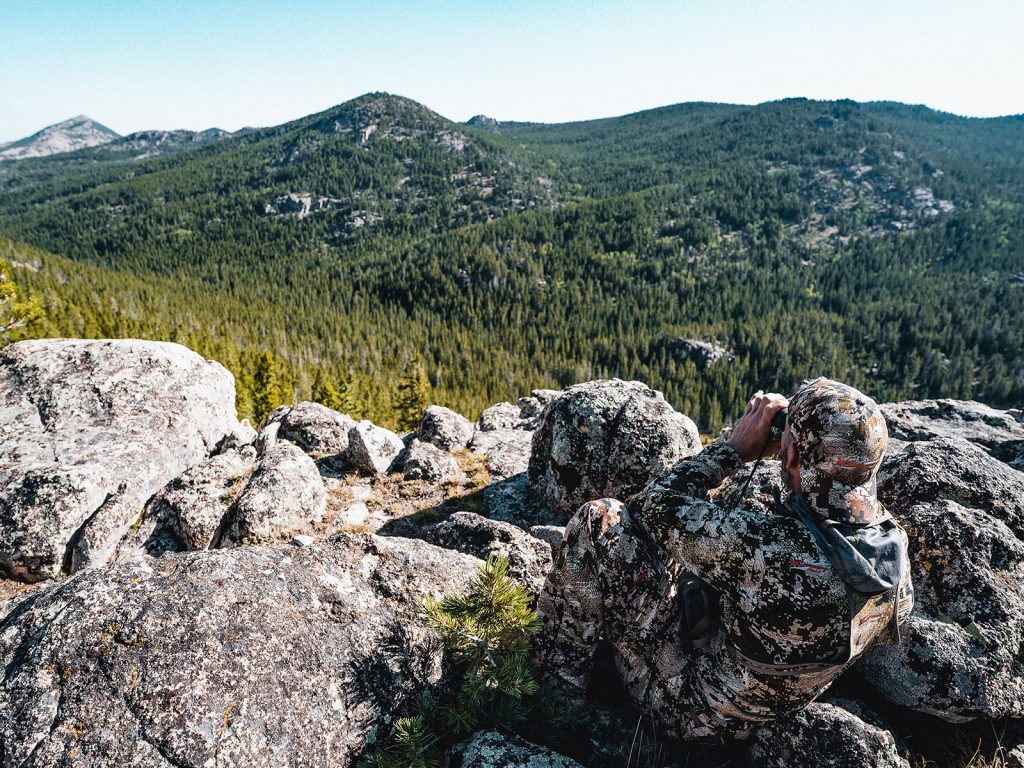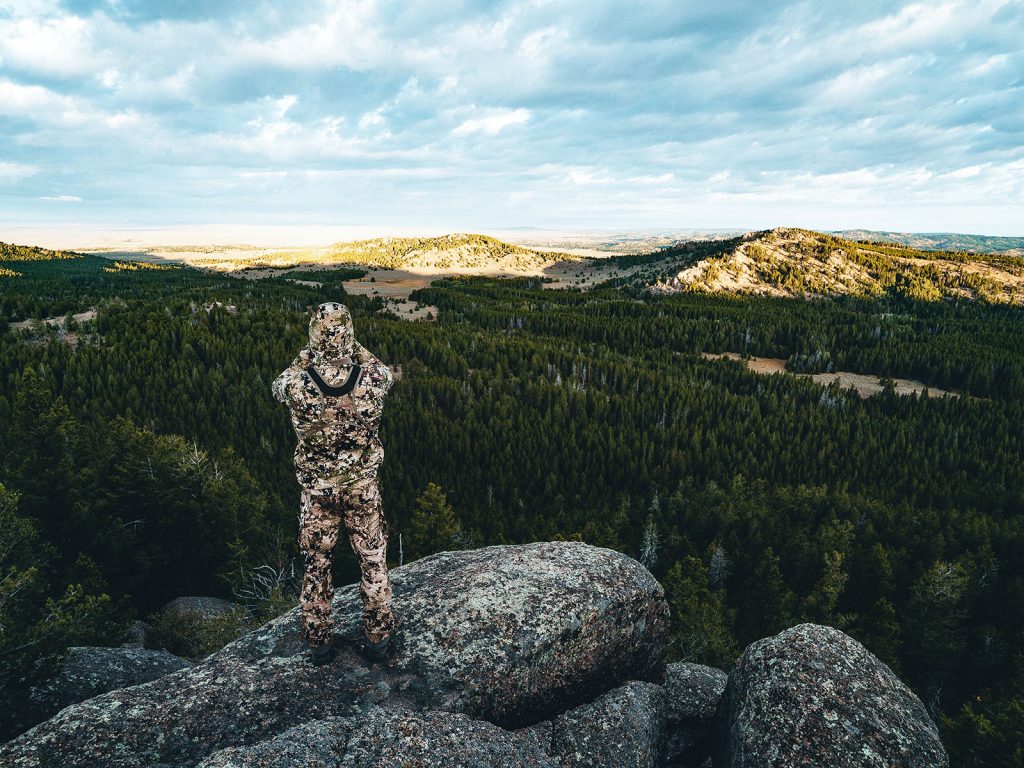
MODULE 15 - POST-RUT & LATE-SEASON
CHAPTER 2: HIDE AND SEEK

RANDY NEWBERG:
WHAT IS A SANCTUARY?
A sanctuary is a place that an elk is going to go where he’s least likely to be disturbed by other hunters. A place where other hunters don’t want to go either because of what it takes to get in there, or what it would take to get an elk out of there.
There are a lot of things that make up sanctuaries. Boundaries are sanctuaries. State borders are sanctuaries. Perhaps the most common sanctuaries we talk about when we’re hunting big, vast tracts of public land are sanctuaries that are created by distance. In other words, how far do you have to hike in to get away from motors. And then there is topography.
A sanctuary created by topography can be canyons. It can be mountains. Maybe it’s a big, sloping mountain that isn’t overly steep, but it’s a long ways to the top. Or maybe it’s just 800 vertical feet that benches out, but that 800 vertical feet causes everyone to say “I don’t want to climb up there!”
Sanctuaries can be created by a public/private boundary. Think about how people hunt near public/private boundaries. Usually, the hunters on the private side don’t want to hunt close to the border for fear of pushing the elk onto the public land. And on the flip-side, the public land hunters don’t want to hunt right at the boundary for fear of shooting an elk and having it jump the fence and not be able to retrieve it.
Boundaries between units – or even between states – can create sanctuaries, usually for the same reason as the public/private boundaries.
All of these boundary areas create sanctuaries, and sometimes they’re the most effective places to hunt because you don’t have a lot of other hunters in these few sanctuaries that might exist in the area. If there’s only one really rough, nasty canyon in your unit, the hunters who understand the importance of sanctuaries are likely going to be there. So, you might want to go look for a boundary that creates a sanctuary, rather than hunting the only topographic sanctuary in the area.
So, distance and topography are the most common features to create a sanctuary, and borders/boundaries are the next most common. Knowing this, how do you find the spot within the area that is the sanctuary?
When bulls go to a sanctuary, it is true that they need food and water. A lot of hunters will look at a big, vast tract of dark timber and think, There has to be elk in there! Sure, there’s a chance there’s going to be some bulls in there, but if there’s no food – or very little food – the elk aren’t going to be as likely to use this area as a sanctuary. If, however, you find a burn, or an opening, or an avalanche chute that is next to a big carpet of dark timber – that’s likely going to be a sanctuary.
Elk want to travel the shortest distance possible to get from security to food and water. The greater the distance they travel, the more they expose themselves to danger. So, they are looking for sanctuary areas that have food and water nearby. When we talk about the Late-Season and there’s snow on the ground, the water component becomes less of a factor, but the food component becomes more of a factor because of the temperature changes.

Elk have to feed more. They’re burning energy during these cold winter months, and they have to get fat back on their body to get through the winter.
Another feature to look for in a sanctuary is the direction it faces. During the Post-Rut and Late-Season, I’m looking for sanctuaries that are somewhere between the Northwest slope and the East slope. Very seldom do I see bulls on a Southeast, South, or Southwest slope during these seasons. It can happen, but I just don’t see it very often when elk are in sanctuary mode.
There are a few reasons why I feel those NW and East slopes hold the elk during the Past-Rut and Late-Season. First, the northern slopes are often riddled with blowdowns. They will often be the slopes that have avalanche chutes. Food sources on these slopes are usually a little bit better in the Late Season. By August, you see how brown the south facing slopes have become, and most of the food has been burnt off these slopes. If you look closely at NW or East or NE slope, you will find that even in September, October, and November, the grass is usually more lush and hasn’t been burned off to crunchy dryness like it usually has been on the south facing slopes.
It’s important to remember that not every spot that is far from a road or a trail or that has a steep climb to get in there is a good sanctuary. There are other components besides security that create a good sanctuary.
One last thing to mention on features that make up a good sanctuary, is that elk like to use areas that would be difficult for us to approach without being heard or smelled. And they want their sanctuary to have a very fast escape route. Once you find some of these sanctuaries that Post-Rut/Late-Season elk are using, you’ll find that it’s likely going to be noisy to get to (scree slope nearby or deadfalls, something), and there’s likely going to be a quick exit into some dark timber, off a cliff, around a corner of rocks, etc.
Sanctuaries are historic places that the mature bulls will use year after year after year because these areas have everything that elk are looking for when they’re trying to avoid hunters. So what does that mean? When you find sanctuaries, don’t share them with anyone! Don’t share them with your brother, don’t share them with anybody unless you want that spot ruined. If you keep that area quiet, there is a very high likelihood that you’ll be able to kill a bull elk in there every year. Sometime during the later seasons, the odds are that you are going to find elk in that sanctuary year after year after year.
The last thing I want to mention on sanctuaries. Remember that we’re talking about Post-Rut and Late-Season sanctuaries. Think about what’s happening from the Post-Rut to the Late-Season. Elk are migrating to (or towards) their winter range. In some places, maybe the terrain is mostly flat and they’re just migrating out into grassland areas from the pinion-Junipers. Here in the northern Rockies, it’s usually an elevation-related migration. The sanctuaries that you’re looking for in the Post-Rut are likely going to be closer to the summer range where the breeding/rut took place. As winter comes, and as the season progresses, the sanctuaries you’re looking for are going to be the ones closer to the winter range.
The cows and the young bulls will be the first ones to head toward the winter range. It usually doesn’t take too much snow or too much colder weather to get them moving. With the mature bulls though, it takes a lot more to get them to leave the security of the high-country or to leave the marginal habitat and head out to the winter range. A lot of times, they will move just a little ways at a time, and not make the full migration that the cows and younger bulls will make. Maybe they’ll move a half-mile or a mile, and find a new sanctuary. The point is, the sanctuaries that are higher or closer to the summer and breeding areas, are the ones you’re going to look for in the Post-Rut period. And as the calendar swings more towards the Late-Season, you’re going to be looking for the sanctuaries that are closer to the winter range.
With all of this being said, there is no perfect science to this. You just have to go and look for sanctuaries. Even if you don’t have a tag, go out and look during the Post-Rut and Late-Season period. You’re going to find the patterns. You’re going to understand what the elk need and where they are finding it. And once you solve this part of the equation, you’ll know what a sanctuary looks like in the area you’re hunting. And year after year after year, you’re going to be able to find bull elk in this area.
PREPARING A STRATEGY
If you have a weekend to hunt - or if you've got four or five days to hunt - you need to have a strategy already in place when you show up. You can't just show up and say, “Well, when the sun comes up I'll look around and figure it out.”
Most of my scouting is done before I even get to the trailhead. E-Scouting, desk scouting, whatever you want to call it, is one of the most critical parts of figuring out what you're looking for and where you're going to find it in the Post-Rut and Late-Season. Once you get accustomed to finding sanctuaries and knowing what a sanctuary looks like, you can look at the lines on a topo map and almost pick out areas that are likely going to be sanctuaries.
I know Corey has already done a really big chapter on using Google Earth in this course – and that's a great tool! A sanctuary is going to be very visible on Google Earth because of its features, or its distance from roads and trails. You will definitely want to identify those areas and have them marked on your GPS or on your cell phone app when you show up.
I just can't over-emphasize the importance of E-Scouting. Let's say you are going on a weekend hunt – you only have Saturday and Sunday. In my E-scouting, I’m going to have three locations identified and marked that are glassing locations. These glassing locations are going to be a function of what sanctuaries I have found and where I found those sanctuaries. For instance, Glassing Spot A will include three or four sanctuaries…little pockets or breaks in the topography. They might be canyons, or cliffs, or burns - something that makes it likely an elk is going to be nearby.
In my E-scouting, I’ve identified these 3 or 4 potential sanctuaries, and then I identify an area that I’m able to hike to where I can glass all 3 or 4 of these sanctuaries. Then, I'm going to move on and identify another group of sanctuaries, as well as a common glassing spot (Glassing Spot B) where I can glass this group of sanctuaries from. And I’ll do that for 3 separate Glassing Spots.
When it comes time to hunt, I get there the night before the hunt. In this case, Friday night. And I want to get there early so I can see . I want to be able to see what's going on. I can read the hunting pressure by how many camps I’m seeing. I can get a clear picture of the weather. I can see if gates have been closed on roads I was planning on driving out. There are all kinds of variables that can wreak havoc on a weekend hunt if I’m not prepared. I’m not able to control hunting pressure or weather, etc., but knowing the situation will allow me to adapt to them if needed. This is why I always try to get to the area the afternoon before I plan to hunt. If I can't get off work early, I try to get there as early in the evening as possible.

That next morning - Saturday morning - I will have Glassing Spot A already picked out. It's my number one spot, the spot I think has the best sanctuary's. These are the spots that I feel are less likely to have hunting pressure, and that are near the needs of what the elk are looking for. Remember, in the Post-Rut and Late-Season, they're looking for sanctuary, sanctuary, sanctuary! Somewhere down the list comes food, and then water. Breeding is not a part of this equation any longer.
You're going to want to be to your Glassing Spot A well before the sun comes up, and you're going to sit there until 11:00 a.m. (maybe noon) glassing and looking, glassing and looking. If nothing happens, then you're going to get up and go to Glassing Spot B. That may mean hiking back out to your truck and driving to a new trailhead. Whatever it takes, you need to be in Glassing Spot B for the afternoon hunt.
Again, Glassing Spot B is going to have another 3-4 likely sanctuaries that you will be able to glass. One thing I should mention is that if it is possible, each of these sanctuaries within a Glassing Spot should have different features. For instance, one sanctuary that you plan to glass could be very near a water source, while another one could be right alongside a great food source. Another one could be adjacent to a burn, or next to a steep, nasty, brushy hillside. It’s kind of like fishing and experimenting with lures. You let the fish tell you what lure they like, or what color they are interested in, or what presentation is most effective.
The whole idea of having a wide variety of attributes in different sanctuaries is that elk will tell you what attribute they're preferring at that time. If you have four sanctuaries where one's close to food, one is close to water, one is steep, and one is next to a burn and you don't see anything…go find four other sanctuaries at Glassing Spot B that have 4 different features. Maybe they're further from that trail. Maybe they're up at the snowline. There are some things that almost have to be found by trial and error, by being there and looking and not doing the same thing every time in every place. Sooner or later, you’re going to uncover the pattern and identify the need that the bull elk are focused on during that weekend that you're hunting. Don't do the same thing at every location! What's the old saying? If you always do what you always done you'll always get what you always got.
Back to the strategy: If you see elk in Glassing Spot A in the morning, you’re not likely going to have time to get a shot that morning. You’re going to need to move and get in position for when he comes out that evening. If you don’t see anything at Glassing Spot A, but find one at Glassing Spot B that evening, again, you probably won’t have time to get in position and get a shot before dark. So, you’re going to be set up and ready and get a shot during the first half-hour of shooting light that next morning. Very seldom in these Post-Rut or Late-Season hunts do I see a bull in the morning and have the chance to go and shoot them that morning. It happens, but not very often.
If Day 1 doesn’t turn up any elk (Glassing Spots A and B), I turn to Glassing Spot C – my last resort. That is what I do the next morning (Sunday morning). And if I don’t have any luck there by 9 or 10, I’m moving out and going into Recon Mode. Yeah, I'm going to carry my rifle. I am going to be hunting, but I'm going to be out there trying to do something different than what I did in my first three glassing locations. When I come back the next weekend, I want to have a slightly different strategy. Sometimes, I might be able to go back to the same Glassing Spots and have different luck the next weekend – if there is a change in the weather, or the hunting pressure, etc. Usually though, I need to collect some recon data to help me narrow down new areas for the next trip.
If I have a few more days to hunt – say it is a 5 day hunt rather than a weekend – I’m going to approach it a little differently. When I show up on a five-day hunt, I going to have five glassing locations ready to hike to. I'm going to do the same thing I would do on the weekend hunt, but I'm going to keep it rolling until I run out of all those glassing locations – ABCDE. I’m still going to have glassing spots that have slightly different features, but I’m going to have more of them. Obviously, the more time I have to pick the area apart, the better off I’m going to be. Over the course of glassing multiple different areas and features, I’m likely going to learn what the elk are focusing on for their needs right then, and narrow down where I will find the elk more consistently.
Click ‘Next Chapter’ Below to Continue to Chapter 3: Tactics for Post Rut/Late Season Elk Hunting





